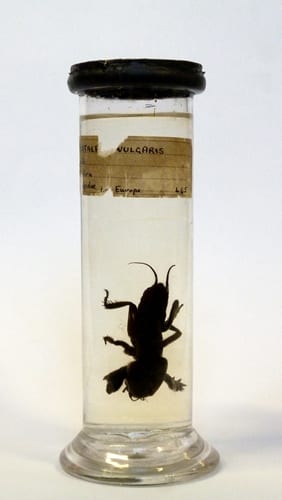Specimen of the week 279: Jar of mole (crickets)
By Will J Richard, on 17 February 2017
Hello! Will Richard here, blogging again for you all. And this time I’ve chosen a specimen that I can’t believe isn’t better known. Everybody loves a jar of moles… so how about a jar of mole crickets?
**the European mole cricket**
Wholly moley
The European mole cricket (Gryllotalpa gryllotalpa) is a terrestrial insect native to damp, fertile soil throughout much of Europe, North Africa and western Asia. They reach lengths of about five centimetres and are named for the dense brown fur that covers their abdomen, their shovel-like forelegs and subterranean lifestyle: making them superficially similar to moles. Like moles they are excellent burrowers and hunt a range of invertebrates underground. Mole crickets, however, also feed on a wide variety of plant roots and seeds that they find in the soil.
Holey moley
Unrelated adults and juveniles live together in a complex network of tunnels. These can be over a metre deep which, to scale that up, is like me digging myself a cave the depth of an 11 story building. To attract females, male mole crickets produce a “churring” song in a specially excavated chamber within their burrow that amplifies this call. After mating females can lay up to 350 eggs in a breeding season and the nymphs take approximately three weeks to hatch. Things then slow down for a while as the young crickets gauge the best time to grow up. They wait until at least the following spring, but can stay “in adolescence” for up to three years if conditions aren’t perfect. Once they begin to mature they moult six times in quick succession before reaching their adult size and developing their wings.

European mole cricket detail. Image by H. Zell via Wikimedia Commons; CC BY-SA 3.0
Lowly moley
Even though the mole cricket is pretty large and ferocious for a temperate insect, it still finds itself quite low down the food chain. They are eaten by a lot of other animals: birds, shrews, big beetles and actual moles. Despite this mole crickets are still numerous across large parts of their ancestral range and have also been introduced to North America. In the UK, however, they are in drastic decline. There have been just four confirmed sightings since 1970, the last of which was in 2001. Some ecologists now consider them extinct from this region. As always it is difficult to be certain as to why, but most agree that increased pesticide use, the drainage of wetlands and the reduction of actually grazed grazing land have all contributed.
References:
Will Richard is Visitor Services Assistant at the Grant Museum of Zoology
 Close
Close



